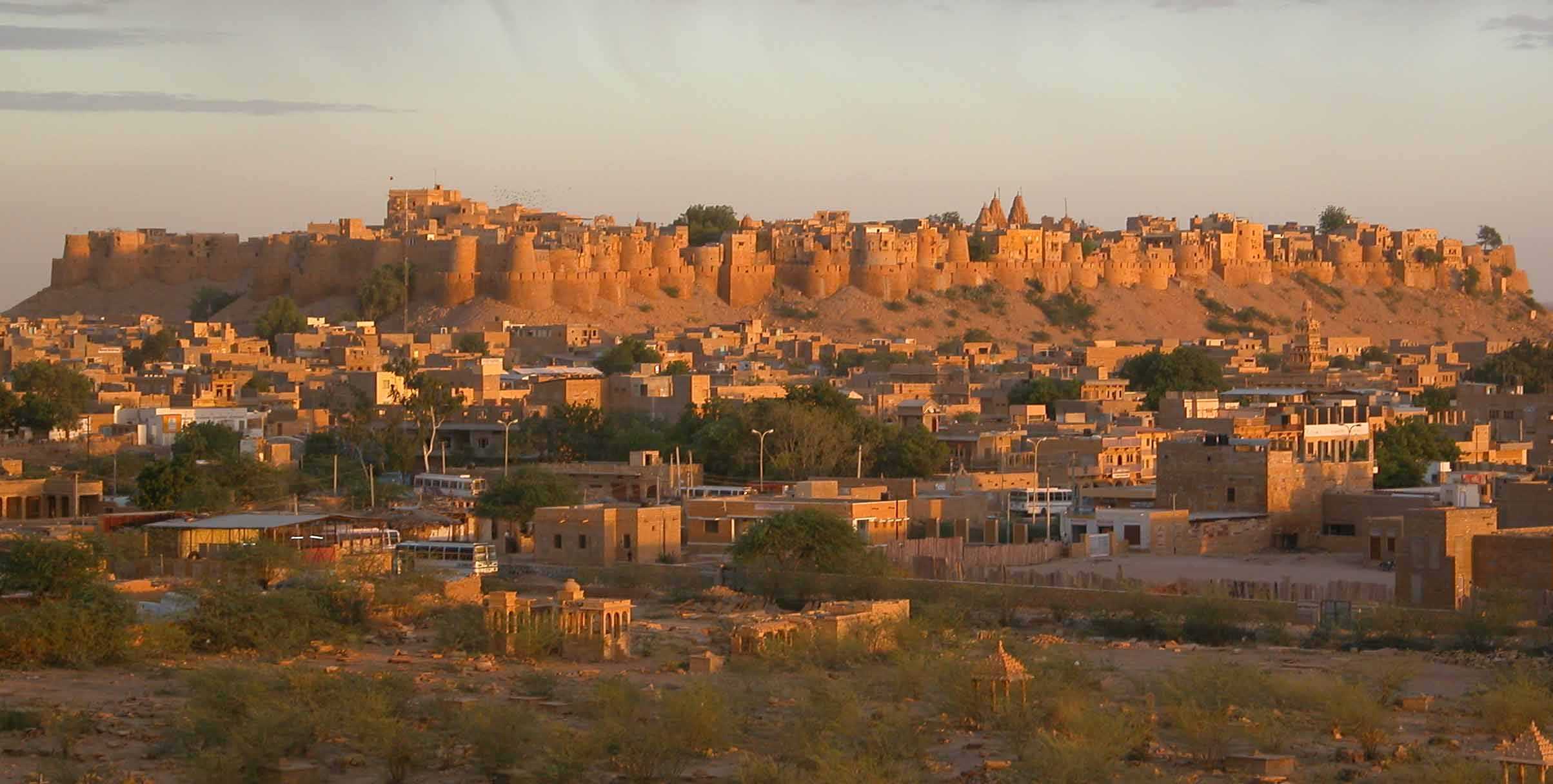
Jaisalmer a town situated in the heart of Thar Desert is popularly known as Golden City just because of the yellow sand stone used in the forts and other buildings of the town giving golden appearance especially in the morning sun light and also in the evening before sun set. Jaisalmer is an important tourist spot in western part of Rajasthan very close to international border with Pakistan. Jaisalmer has come a long way since being an important town along the ancient camel-train route ran through India and Central Asia. Over the centuries, the fortunes of Jaisalmer have risen and fallen, thanks to geo-politics of the region and of course emerging of newer trading routes. Jaisalmer was being ignored by British rule for a long time and also by government of India after Independence, but the war of 1965 and 1971 with Pakistan made govt. of India to understand the importance of Jaisalmer and once again the fortune of Jaisalmer became alive. Jaisalmer is known to have a big military installation and one of the prominent tourist spots in Rajasthan.
History:
Rawal Jaisal, a king of Bhatti Dynasty had established his new capital in 1156 in the form of a mud fort atop of the Trikut Hill and named it Jaisalmer. Prior to this the Bhatti Rajput clan’s capital was situated in Lodhruva nearly fifteen kilometers to the south-east of Jaisalmer. Like histories of most of the Rajasthani cities Jaisalmer too has a legendary episode. It is said that Lord Krishna had predicted the establishment of an incredible kingdom of one of the kings of his clan in 12 Th centuries. After the establishment of new capital, Raja Jaisal decided to impose taxes on the camel caravans passing through the neighboring roots. Those days trading caravans loaded with silk, exotic spices and other expensive things between Delhi and Sind travel through Jaisalmer. The strategic location of Jaisalmer on the trading route to Egypt, Africa, Persia, and other western nations made the capital city Jaisalmer wealthy and prosperous. Sikh Jats of Majha, Malwa and Doab and the rulers of Kapurthala states in Punjab had their links to Jaisalmer royal families over the centuries. Jaisalmer grew stronger and prosperous in about one and half century. There was a black spot in the history of Jaisalmer when Alauddin Khilji attacked Jaisalmer in 1294. Bhatti warriors defended for more than eight years but ultimately they were defeated by Mughal army. This defeat had been resulted a big Jauhar (self immolation) by the women of the kingdom. Later on descendants of the Bhatti clan ruled Jaisalmer under agreements with Mughals till the British rule.
Culture:
Jaisalmer is considered to be cultural hub of western India as well as a key tourist destination. Jaisalmer is blessed with a colorful and vibrant culture that reflects the rich heritage of the past traditions, the desert city’s folk music and dance, different social customs and classical belongings in music and dance. The culture, language and traditions of Jaisalmer are widely influenced by the culture, language and tradition of Sind, perhaps due to neighboring province. It is the culture of Jaisalmer which attract thousands of tourists from country and abroad to visit this wonderful town and have a taste of desert life. The climatic conditions and the terrain of dwelling seem to be very difficult but the people of Jaisalmer look very happy and satisfied with their lives, very friendly in nature and jovial by their appearance. Majority of population live in rural area, their homes are in fact huts made of mud and grass. People earn their livelihood by farming and cattle rearing. Most of the population follows Hindu religion and culture, some other religious community such as Jain and Sikh do reside here but all follow Hindu traditions and rituals. Jaisalmer has a big population of Marwari community, speaking Rajasthani and followers of Hindu traditions and customs.
Traditional Costumes:
The town Jaisalmer looks golden but the traditional costumes of the people of Jaisalmer are more bright and colorful. The people of Jaisalmer are often seen wearing bright colorful garments of pink, red, green, yellow and blue in colors. During festive seasons women wear more colorful Ghaghra-Choli or Lehenga-Choli along with elaborate beautiful jewelry made of gold, silver and brass. Women also wear a Odhni, a 2-3 meter long colorful and decorated cloth for upper parts of the body, head to breast. Males wear Dhoti and Angarakhi or Jhari which is like a jacket colorful and decorated with mirrors and metals. Traditional dresses for males in Jaisalmer include Khol, Pachewara, Bugatari and Banda. A key aspect of the male costumes is their headgears, including Pagri, Potia, Saafa, Sela and Pencha.
Music and Dance:
Folk music and folk dance of Jaisalmer is an important part of the cultural identity of the town. The folk music and folk dance form of the region are being passed on from one generation to next generation and became the main attraction among visitors of the city. Cultural and social celebrations in Jaisalmer are full of folk music and dance performed by renowned artists of local fame. Many native dance styles that Jaisalmer can boast of, the Kalbelia dance style being one of them. This dance style is primarily performed by the community of snake charmers. Other prominent dance forms in Jaisalmer are Ghoomar Dance and Kathputli Dance. Ghoomar dance is a special dance form of Rajasthan performed by a group of women on festive occasions. Kathputli Dance form is folk dance form of Jaisalmer in which organizers use their creative imagination to arrange a dance drama of puppets to entertain the audience.
Arts and Crafts:
Jaisalmer is well known for its arts and crafts which include delicate embroidery work, traditional jewelry made of silver, beautifully crafted leather products, stone carving, fabric printings and blue pottery works. Most of the skilled artists and craftsmen belong to the town and this is evident in the architecture of the Temples, Forts and Havelis of Jaisalmer. Most of the edifices in Jaisalmer are elegantly adorned with delicate and fine work. People from all over India and also from each corner of the world visit Jaisalmer to see the Forts, Palaces, Havelis, Temples and religious shrines that bear astounding lattice work on their walls, pillars and ceilings.
All Around the World Tours Dummy text ever since the 1500s, when an unknown printer took.
Immigration & Passport Help Dummy text ever since the 1500s, when an unknown printer took.
Private & Customized Tours Dummy text ever since the 1500s, when an unknown printer took.
All Around the World Tours Dummy text ever since the 1500s, when an unknown printer took.
Private & Customized Tours Dummy text ever since the 1500s, when an unknown printer took.
All Around the World Tours Dummy text ever since the 1500s, when an unknown printer took.
Immigration & Passport Help Dummy text ever since the 1500s, when an unknown printer took.
Private & Customized Tours Dummy text ever since the 1500s, when an unknown printer took.

Inspire you to explore India tours beyond the usual well-known locations.
Lorem ipsum dolor sit amet, consectetuer adipiscing elit. Aene an commodo ligula eget dolor. Aenean massa. Cum sociis the
Lorem ipsum dolor sit amet, consectetuer adipiscing elit. Aene an commodo ligula eget dolor. Aenean massa. Cum sociis the

Plan your day by day itinerary for your vacation with Private Car and Driver or Tour Packages.
Three days and two nights are sufficient for the Jaisalmer tour to see its attractions and taste the city's culture.